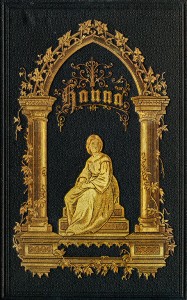DOWNLOAD: XHTML

[Jacob Freund] taught religion at the Jewish community’s religious school in Breslau….in addition to songs, Jacob Freund wrote numerous poems and was a member of the Breslau Association of Poets (Verein Breslauer Dichter-schule). Despite his humble economic status, Freund…was a prominent member of Breslau’s Jewish community, well known as a prolific writer of religious literature, including a reform-oriented prayer book for girls and women, which saw many editions. Occasionally, Jacob Freund even mixed his artistic and religious talents, as in his farce Hawaii oder die Redlining ohne Wirth: Fosse mit Gesang in fiinf Akten.
The title of the collection is a direct reference to the biblical figure, Ḥanna whose petitionary prayer for a child was answered with the birth of her son, the prophet Shmuel. Besides teḥinnot, Hanna, contains translated portions of prayers found in the daily siddur and holiday maḥzor. Among the many teḥinnot included there are a “Prayer of a newlywed”, “Prayer for a sick father”, “Prayer of a mother on the day of the Confirmation of her son”, “Prayer of a widower.” Hanna ends with a large section for cemetery prayers. Other, more intimate or day-to-day references found in Stunden Der Andacht, relating to taharat hamishpaha or haphrashat halla are notably absent.
Hanna was reprinted at least nine times between 1867 and 1908. (Digital scans of the original 1867 edition are available from the Internet Archive, and Google Books). My work is a transcription of the latest Public Domain edition from 1908, and includes the work David Feuchtwang, (chief rabbi of Austria from 1931-1936). As far as we can tell, this new digital edition is the first edition published since 1908.
The work has been carried on with the help of volunteers from Project Gutenberg Distributed Proofreaders. The initial transcription was made using the open source software, Tesseract-OCR, which was able to read the gothic German Fraktur typeface. The transcription was subsequently proofread and formatted in many rounds by PGDP voulnteers. The little Hebrew in this book was either typed in directly, or retrieved from parallel sources (most of it consisting just of Tanakh verses or excerpts from prayers), checked and adapted. Finally, the proofed text was post-processed into xhtml and epub files (following the customary PGDP practice).

“📖 Hanna. Gebet- und Andachtsbuch für israelitische Frauen und Mädchen. (Jacob Freund et al, 1867)” is shared through the Open Siddur Project with a Creative Commons Public Domain Dedication 1.0 Universal license.










Is it fair to say that, although today a separate at-home liturgy for women would hardly seem progressive, that providing women with these prayers in German was seen as progressive (or even a precursor to feminist) at that time?
I think the precedent had already been set a decade earlier by Fanny Neuda (Stunden Der Andacht, 1855). Preparing women’s prayers in French had been done by Jonas Ennery in 1848. I wouldn’t be surprised if there are other examples of late tkhines/tehinnot literature written for women in regions where Yiddish was unfamiliar.
Any english translations with commentary..would LOVE such thing..